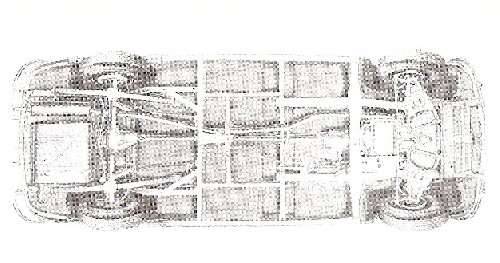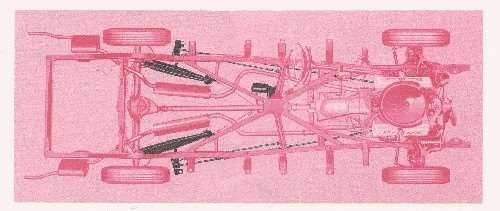Re: Packard & Hudson proximity
Posted by Steve203 On 2014/8/22 11:08:55
Just finished the Langworth book on Hudson. This book was written in the mid 70s, when many of the principle people were still around. Langworth interviewed Nance and Chapin, among others.
There is a long section of Nance describing the projected 4 way merger. Nance said he got the job of working with Studebaker because Mason told him he couldn't get anywhare with Hoffman and Vance. Nance also claimed the plan was to drop the Rambler because, in the four way tieup, Studebaker would be the cheap brand and Nash having the Rambler would not fit in the market positioning of the brands.
Chapin talked about the need to get out of the Hudson Jefferson plant. He said it had workflow issues, the union was agressive and the plant itself had not been maintained for 10, maybe 20, years and was in very poor material condition.
The book also has the terms of the Hudson/Nash merger. Packard ended up on the wrong end of the S-P merger because of how the stock swap was structured.
At the time of the merger, Packard's market capitalization was a bit over $50M, while Studebaker's was $35M, but the stock swap was based on book value, which put Studebaker on top at $108M vs Packard's $83M.
At the time of the Hudson/Nash merger, Hudson's market cap was slightly under $19M. Langworth doesn't give a clue about Hudson's book value, but I'd say it's safe to say that Packard would have been the dominate partner. Nance would have been President, which suited him, and Barit would take a seat on the board, as he did with Nash.
So a Packard/Hudson merger could start out with Hudson being a retrimmed Clipper for 55-56 as the Packard body was less obsolete than the step-down.
As for 57 on, the Langworth book has what I have been looking for for some time: a clear illustration of the underside of the stepdown platform. To my eye, it looks like there is room for the Torsion-Level system. The front seat of the Hudson appears to sit on an elevated platform in the floorpan, which would make room for the crossbrace that anchors the leveling motor and it's torsion bars. The Hudson back seat is also on an elevated platform, which would make room for the trailing arms for the T-L rear suspension.
So 57 design would come down to the Hudson engineers designing the greasy side and Packard designing the shiny side, with the one condition that the Hudson crew had learned from the first generation stepdown and was able to design it so restyling was cost effective.
If a suitable mono-built platform can be designed, then use the years with production consolidated at EBG to rennovate Jefferson, then move back to Jefferson in 57 and use the millions of dollars of line equipment that had been installed in 48. If a suitable mono-built platform cannot be created, then stay at EGB and move to a perimeter frame, with lateral braces under the seats, instead of an X member, to allow the floor to be dropped, while still leaving enough room for the torsion bars.
Attach file:
 (72.48 KB)
(72.48 KB)

 (72.20 KB)
(72.20 KB)

There is a long section of Nance describing the projected 4 way merger. Nance said he got the job of working with Studebaker because Mason told him he couldn't get anywhare with Hoffman and Vance. Nance also claimed the plan was to drop the Rambler because, in the four way tieup, Studebaker would be the cheap brand and Nash having the Rambler would not fit in the market positioning of the brands.
Chapin talked about the need to get out of the Hudson Jefferson plant. He said it had workflow issues, the union was agressive and the plant itself had not been maintained for 10, maybe 20, years and was in very poor material condition.
The book also has the terms of the Hudson/Nash merger. Packard ended up on the wrong end of the S-P merger because of how the stock swap was structured.
At the time of the merger, Packard's market capitalization was a bit over $50M, while Studebaker's was $35M, but the stock swap was based on book value, which put Studebaker on top at $108M vs Packard's $83M.
At the time of the Hudson/Nash merger, Hudson's market cap was slightly under $19M. Langworth doesn't give a clue about Hudson's book value, but I'd say it's safe to say that Packard would have been the dominate partner. Nance would have been President, which suited him, and Barit would take a seat on the board, as he did with Nash.
So a Packard/Hudson merger could start out with Hudson being a retrimmed Clipper for 55-56 as the Packard body was less obsolete than the step-down.
As for 57 on, the Langworth book has what I have been looking for for some time: a clear illustration of the underside of the stepdown platform. To my eye, it looks like there is room for the Torsion-Level system. The front seat of the Hudson appears to sit on an elevated platform in the floorpan, which would make room for the crossbrace that anchors the leveling motor and it's torsion bars. The Hudson back seat is also on an elevated platform, which would make room for the trailing arms for the T-L rear suspension.
So 57 design would come down to the Hudson engineers designing the greasy side and Packard designing the shiny side, with the one condition that the Hudson crew had learned from the first generation stepdown and was able to design it so restyling was cost effective.
If a suitable mono-built platform can be designed, then use the years with production consolidated at EBG to rennovate Jefferson, then move back to Jefferson in 57 and use the millions of dollars of line equipment that had been installed in 48. If a suitable mono-built platform cannot be created, then stay at EGB and move to a perimeter frame, with lateral braces under the seats, instead of an X member, to allow the floor to be dropped, while still leaving enough room for the torsion bars.
Attach file:
 (72.48 KB)
(72.48 KB)
 (72.20 KB)
(72.20 KB)
This Post was from: https://packardinfo.com/xoops/html/modules/newbb/viewtopic.php?post_id=148940